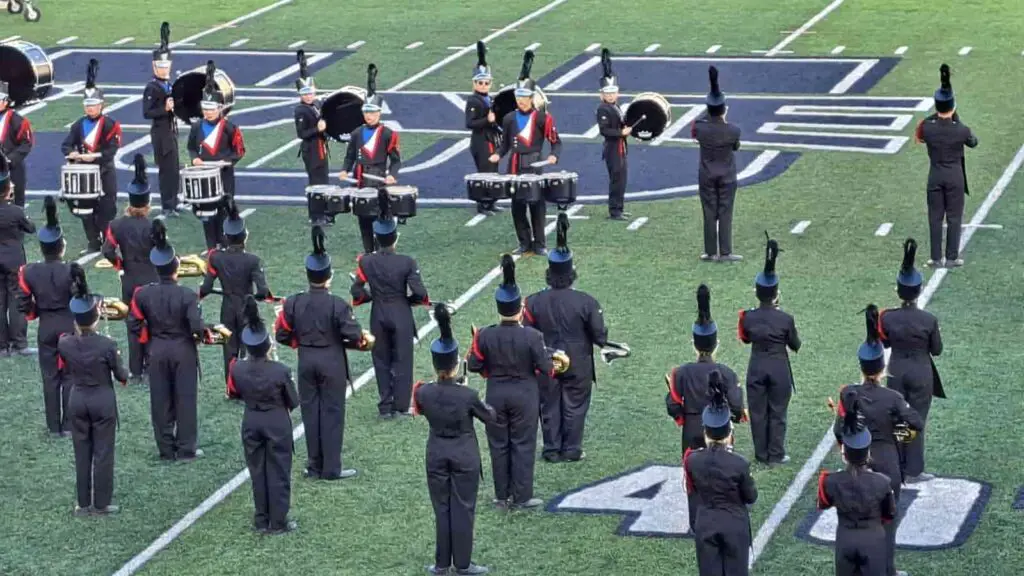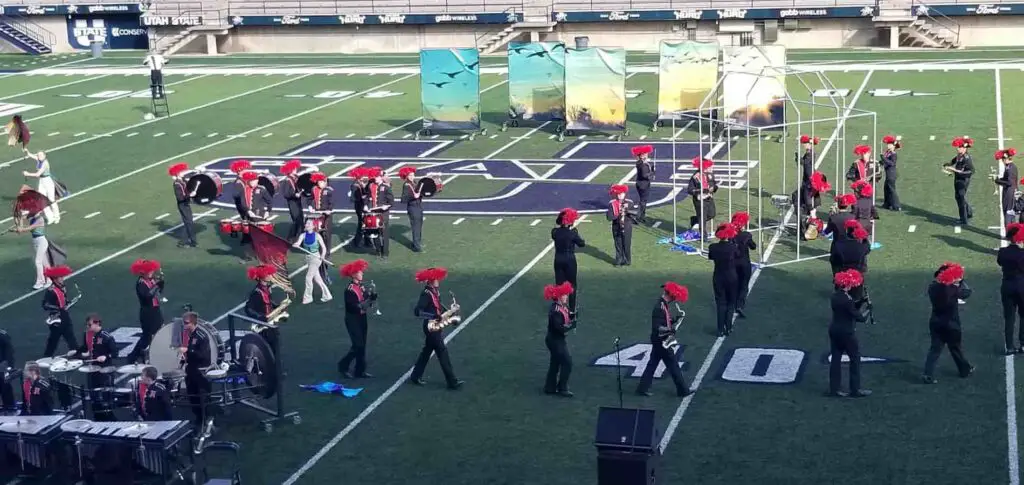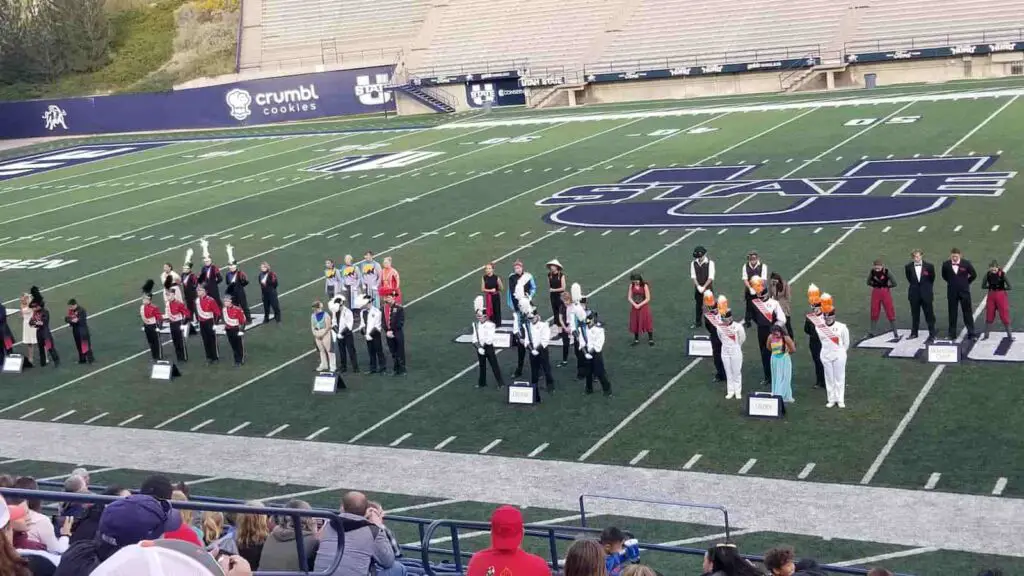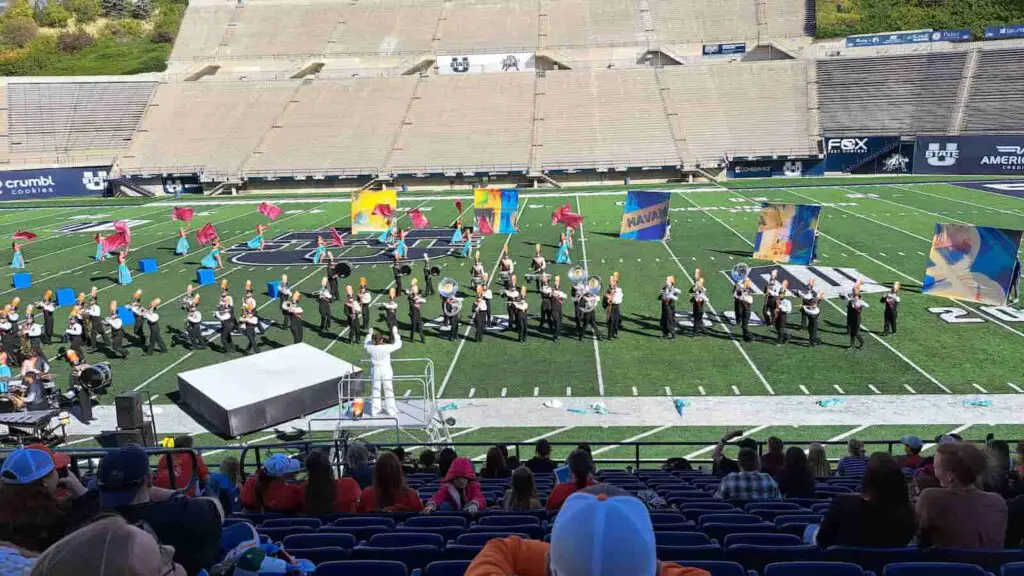Marching band competitions are one of the best parts of being a part of your high school’s marching band.
You will travel around in or outside the state on a Saturday, perform your show for judges, and watch other schools’ shows while hanging out in the stands with your friends, snacking on some cheese fries or fried Oreos.
Since marching bands come in many different shapes and sizes, band competition associations classify bands into different divisions based on how many students attend the school you represent or how many performers you will have on the field.

Why Marching Bands Use Size and Classification in Competitions
Using size titles and classifications, the adjudicators and those running the competition ensure every band has an equal opportunity to compete against similar bands.
If a marching band has a new director and the band is reforming/the program is being built, and there are only 30 musicians on the field, they cannot be compared to a marching band with 80 musicians, 35 members of the auxiliary, and elaborate props.
The bigger band with a long-established marching history would win against a new program band.
It is not the members of the band’s fault that they are small and shouldn’t be punished or humiliated in competitions.
Think about it like this, if you had to compete in a swimming race and your opponent was an Olympic swimmer, would you want to compete? No, there is no way you can beat someone with years of training who competes on a global scale.
You would quit the swim team if every swim meet were against Olympians because no matter how hard you try, it isn’t a fair race. The same applies to marching bands. Small bands compete against other small bands, and large bands compete against large bands at most competitions.
Note: Each marching band association in every US state will have its own size classifications. The band director’s job is to read the rules and register their band at the proper competition level. Different competitions have different size classifications and will use different titles, such as A, 3A, Open, Gold, or anything like that in which your band can be sorted.
Your band might be the only competitor in your division, or your band can be against ten other high school bands in a single division. Due to the wide variation of classification titles and meanings, we will examine five different marching band association classifications.
Two of the associations welcome bands across the country to compete, and three of the associations are region-specific. Many band associations operate in the United States, and the classification systems used by each vary.

Bands of America (BOA)
The first competition association is Bands of America or BOA for short. BOA is a music education advocacy organization that organizes and promotes high school marching band competitions across the United States.
Bands of America championship events are open to all high school marching bands on a first-come, first-serve basis. There are no qualifications or prerequisites for band participation.
Note: Many BOA competition bands aim to attend the Grand National Championship to bring home a trophy for one year, and your school’s name will be added to the list of previous championship winners.
Bands participating in a Bands of America run competitions are assigned competitive classes based on their school’s enrollment (grades 10-12).
With BOA, the top 12 highest-scoring bands will advance to finals performance regardless of the class. Judges and audience members are not told what class a competing band is to prevent influential scoring (ex: assuming a big band = big points)
Take a look at the chart below to see how BOA bands are divided into classes.
| Class | # of Students Enrolled at the High School |
| A | 600 or fewer students |
| AA | 601-1,250 students |
| AAA | 1,251 – 1,750 students |
| AAAA | 1,751 and above students |
The classes are called by the following names: A, 2A, 3A, 4A.
Organizing competing groups into classes based on the number of students currently enrolled at the high school is one way to sort bands for competition. However, some schools with large numbers of enrolled students have tiny band programs.
In this scenario, the number of students in the school does not reflect the number of people in the band. Don’t worry if your school is in the 4A division and there are only 15 people in the marching band; you are not being judged based on the size of your band, only the marching technique, musical performance, and visuals.

USBANDS
The next large band association we will be looking at is USBands, formerly the United States Scholastic Band Association or USSBA. USBands was created in 1988 to provide high school band programs with a competitive circuit judged by top adjudicators across the country.
Note: Over 700 marching bands are USBands members, and the two major competitions everyone is trying to get to are the Regional Championships and US Scholastic Band Championship.
The main thing about the USBands classification system is that bands must classify themselves on proficiency and size.
There are three proficiency levels:
Performance Class is for bands that want to attend a competition to perform but are not competing. This proficiency class is for bands wishing to present their show to judges for general feedback, not points or awards.
A Class is for bands who demonstrate a basic – intermediate skill set (bands that are building or rebuilding their band programs fit here) and will be judged on a scale of fundamental to intermediate skills.
Open Class is for seasoned bands that can demonstrate more “expanded skills” and are judged on a scale from intermediate to advanced skills.
Unlike BOA, USBands classify competing bands by the number of playing members, auxiliary, and command personnel in the band.
Group 1 bands are the smallest, and Group 5 bands are the largest.
A Class is for “inexperienced bands, new bands, and bands that have moved to a larger size group.” Open Class is for established band programs. The classification process results in 12 groups ranging from Group 1 A to Group IV Open. This sounds a lot more confusing than it is, but the chart below will explain the classifications.
NOTE: USBands have different requirements for class titles in Texas and will be included in a second chart.
| Group | # of Performers | Proficiency Class | Full Title |
| I | 1-39 performers | A Class | I A Class |
| I | 1-39 performers | Open Class | I Open Class |
| I | 1-39 performers | Performance Class | I Performance Class |
| II | 40-54 performers | A Class | II A Class |
| II | 40-54 performers | Open Class | II Open Class |
| II | 40-54 performers | Performance Class | II Performance Class |
| III | 55-74 performers | A Class | III A Class |
| III | 55-74 performers | Open Class | III Open Class |
| III | 55-74 performers | Performance Class | III Performance Class |
| IV | 75-99 performers | A Class | IV A Class |
| IV | 75-99 performers | Open Class | IV Open Class |
| IV | 75-99 performers | Performance Class | IV Performance Class |
| V | 1oo+ performers | A Class | V A Class |
| V | 1oo+ performers | Open Class | V Open Class |
| V | 1oo+ performers | Performance Class | V Performance Class |
* Chart shows the 2022 USBands Fall Marching Classifications
| Texas Group | Texas # of Performers |
| I | 1-59 performers |
| II | 60-99 performers |
| III | 100-139 performers |
| IV | 140-169 performers |
| V | 170+ performers |
* Chart shows the 2022 USBands Fall Marching Classifications Texas

Tournament of Bands (TOB)
The Tournament of Bands (TOB) is one of the largest competitive band organizations in the United States. TOB is also one of the major circuits for mid-Atlantic States (USBands is another).
Created by the National Judges Association in 1972, TOB has over 439 member bands. TOB does more than just marching band competitions. They also offer indoor winter guard, majorette, percussion, and dance team competitions in the Spring.
Note: The Tournament of Bands is unique because it is open to all school levels, from elementary to collegiate marching bands. Marching band competitions are usually only held for high school students because that is when most students have the opportunity to join a marching band.
The Tournament of Bands makes marching music and the marching arts accessible to any student at any level. Current TOB states include:
- Delaware
- Maryland
- West Virginia
- Virginia
- Ohio
- Pennsylvania
- North Carolina
- New Jersey
- New York.
The Tournament of Bands is divided into four Groups, which can compete in 3 different Class Levels of performance.
OPEN CLASS (formerly Championship) is the level where bands compete throughout the season for TOB scoring and finish the season with the annual Chapter Championship to qualify for the annual Atlantic Coast Championship.
A CLASS (formerly Regional) is the level for bands with less experience competing. An A CLASS band will compete throughout the season following TOB scoring, but the emphasis is on education and development. In this class, student education, development, and staff training are what the bands will be working on.
FESTIVAL CLASS, this level introduces bands to the TOB style of competitions. The bands will compete at an exhibition level, and awards are based on a rating system rather than a numeric score or place. FESTIVAL CLASS focuses on education and development like A CLASS level, but the FESTIVAL CLASS ends the season with the annual Chapter Championship.
Every TOB competition offers three levels of participation in every group. Chapter Championships include three levels of participation and awards. The Atlantic Coast Championship is only open to OPEN CLASS and A CLASS bands. Let’s look at how the TOB classifies its groups based on the band’s size and the number of auxiliary members.
| Group | # of Musicians | Maximum # of Auxiliary |
| Group 1 | Up to 30 musicians | 30 |
| Group 2 | 31-50 musicians | 50 |
| Group 3 | 51-75 musicians | 75 |
| Group 4 | 76+ musicians | N/A |
Mid-States Band Association (MSBA)
The Mid-States Band Association (MSBA) is a coalition of high school band organizations centered in and around the Dayton, Ohio, area.
As of 2021, MSBA member schools come from Ohio, Kentucky, Indiana, and Michigan.
The Mid-States Band Association has a unique classification system that is based on the number of winds, percussion, and electronics performers (keyboard, theremin, etc.) Any auxiliary person that plays a wind, percussion, or electronic instrument at any time during the show shall be counted as a playing member for the purpose of determining a band’s class.
Members of the color guard, majorettes/feature twirlers, or dance team do not count as “band members” in MSBA classification determinations.
Note: If a member or members from the auxiliary play an instrument, even for a short amount of time, they can and will be counted in the class determinations. MSBA is the only association in this article with this rule about auxiliary members.
Another unique rule that applies to MSBA classifications is that physically disabled performers (including blind or vision-impaired musicians) who want to be part of a marching band are permitted to compete with a handler/assistant if needed.
No penalties will be applied if a student is pushed in a wheelchair or guided by a sighted student or a member of the band’s adult staff. Only the student playing an instrument will be included in the classification numbers, not the handler or assistant. Let’s take a look at the classifications for an MSBA member band.
| Class | # of Playing Members |
| Class A | 1-29 playing members |
| Class AA | 30-44 playing members |
| Class AAA | 45-59 playing members |
| Class AAAA | 60-89 playing members |
| Class AAAAA | 90+ playing members |
The classes are called by the following names: A, 2A, 3A, 4A, 5A.
Northwest Association for Performing Arts (NWAPA)
The Northwest Association for Performing Arts is the governing body and a competitive circuit of high school marching bands, color guards, and percussion groups headquartered in Portland, Oregon.
Most member bands/high schools in the NWAPA are from Oregon, Washington, Idaho, and California. During the fall marching band season, over 5,000 students and 20,000 spectators attend NWAPA events from September to November every year.
Three significant competitions organized and governed by the NWAPA include:
- The Pacific Coast Invitational
- Sunset Classic
- The University of Oregon Festival of Bands
The competition season concludes with the NWAPA Championships that take place either the last Saturday in October or the first Saturday in November at either the University of Oregon or Oregon State University.
NWAPA member bands are classified based on the number of marching members within each ensemble, including percussion and auxiliary/color guard.
Note: There are four official classes, and there is an Exhibition/Festival Class that is specifically for visiting bands who want to take part in a performance opportunity. Exhibition/Festival Class bands only receive comments from adjudicators instead of scores or awards.
This is how NWAPA classifies its competing bands.
| Class | # of Marching Members |
| A | Up to 49 marching members |
| AA | 51-59 marching members |
| AAA | 60-89 marching members |
| AAAA | 90+ marching members |
| Exhibition | Bands of any size, comments only |
* Chart shows the Fall 2021 Class Divisions.
There is no unified or widely adopted system of classifications for marching bands. Still, most classifications are calculated by the number of members or the total number of students enrolled at the school. Each state/district/region/competition circuit in the country will have written policies determining how a band will be classified for that competition.
This means at one competition; your band may be classified by marching members and receive the classification of AAA (aka 3A) (55-89 members).
At another competition, your band is classified by the number of students enrolled at the high school. Which may classify the band as A because fewer than 600 students are enrolled in the school.
Two different competitions/rules and two different classification titles for the same band. You can see why classification designations can be so confusing. If your school sticks to one circuit like the Bands of America and only competes in BOA competitions, the classification designation will remain the same throughout the season.
If you want to know how your band will be classified at each competition, you can go to the competition’s website and search for the rules and regulations. In the end, the classification of your band is not a measure of skill and success. The classifications ensure your band is competing against similar-sized groups to make the competition fair for all participating bands.
We hope this article has been helpful and informative for you in your musical journey. Please let us know if there is anything that we could add or change to make this article a better resource for our readers.
Please e-mail us at: [email protected] to let us know how we are doing!
Disclaimer: This post may contain affiliate links. We only recommend high-quality products that are used and recommended by real musicians. If you use these links to buy something we earn a small commission.
